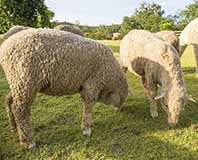Read the latest information on
Foot-and-mouth disease
 Despite the dry winter across much of New South Wales, an outbreak of virulent footrot in the state’s Central West and Greater Sydney regions has prompted reminders for all producers to be vigilant of disease incursions, regardless of climate conditions.
Despite the dry winter across much of New South Wales, an outbreak of virulent footrot in the state’s Central West and Greater Sydney regions has prompted reminders for all producers to be vigilant of disease incursions, regardless of climate conditions.
Footrot is a highly infectious disease affecting the connective tissue around the hooves of sheep and goats, resulting in lameness in infected animals. The bacterium Dichelobacter nodosus, which causes the disease, spreads more easily between animals in a herd or flock in warm, wet or muddy conditions.
Virulent footrot is a notifiable disease in most jurisdictions, except for Tasmania and the Northern Territory.
As the disease progresses, infected animals become increasingly lame, leading to a serious loss in production. Once established in a herd or flock, footrot can be difficult to fully eradicate and – as infection results in quarantine in most states and territories – puts significant financial pressure on producers.
Dr Rob Barwell, Acting Executive Manager – Biosecurity and Product Integrity Services at Animal Health Australia, says preventing and controlling outbreaks of footrot and other diseases is vital, even when conditions do not indicate a heightened threat.
“Producers should be vigilant about which animals they bring on to their property and ideally they should come with a completed Animal Health Declaration,” Dr Barwell explained.
“Check for signs of footrot and other conditions, preferably before you buy. Always isolate new stock to prevent the spread of any diseases, pests or weed seeds.”
If an outbreak occurs on a property, the producer is responsible for ensuring the threat is contained and if possible eradicated.
“Good fencing is the key to ensuring infected stock aren’t able to mingle with healthy stock or stray onto public land,” said Dr Barwell.
“For most threats prevention is a good deal easier than eradication. Sound biosecurity practices, as part of everyday farm management, can greatly reduce the risk of a disease, pest or weed gaining a foothold on a property.”
As virulent footrot has become less prominent over the past 20 years, many producers may be unfamiliar with the signs or mistake the infection for another disease, especially given the weather throughout winter.
Any sign of pain and discomfort affecting an animal’s hooves should be investigated as a possible case of footrot. If you suspect virulent footrot is present in your herd or flock, contact your state Department of Primary Industries/Agriculture or your veterinarian.
Tips for implementing proactive biosecurity practices can be found on the Farm Biosecurity website.